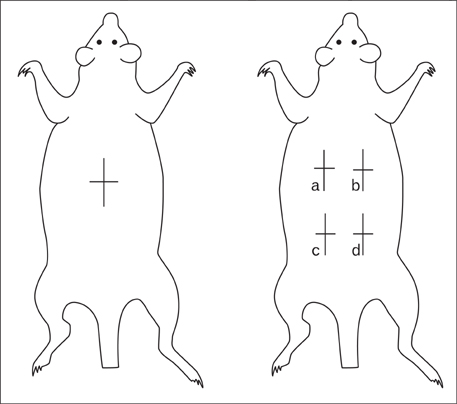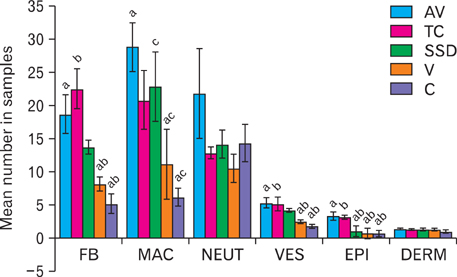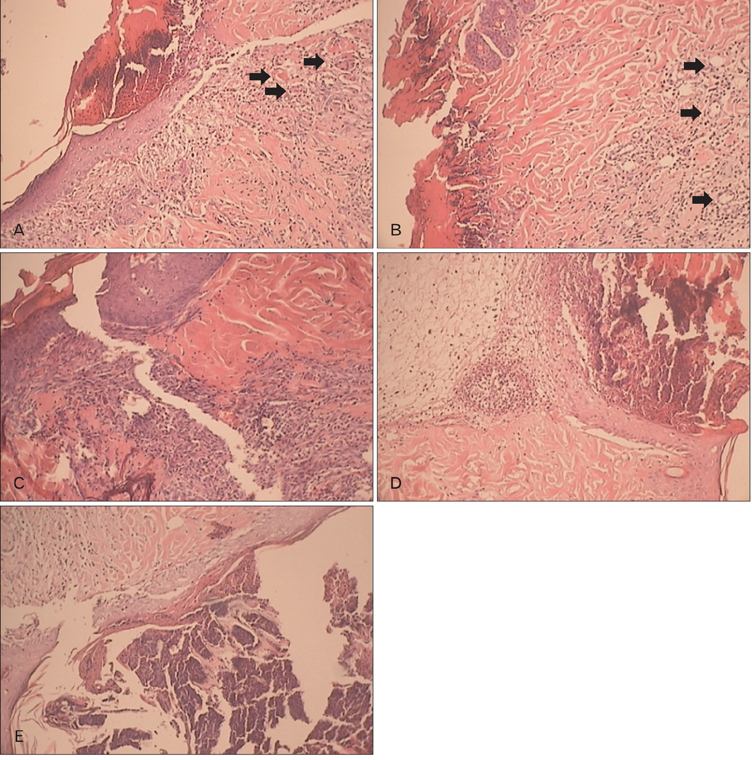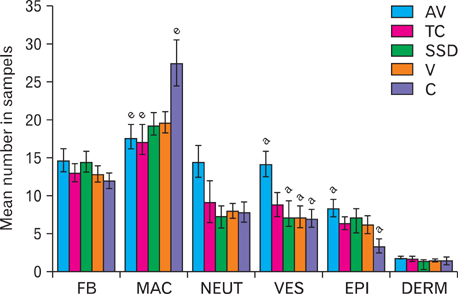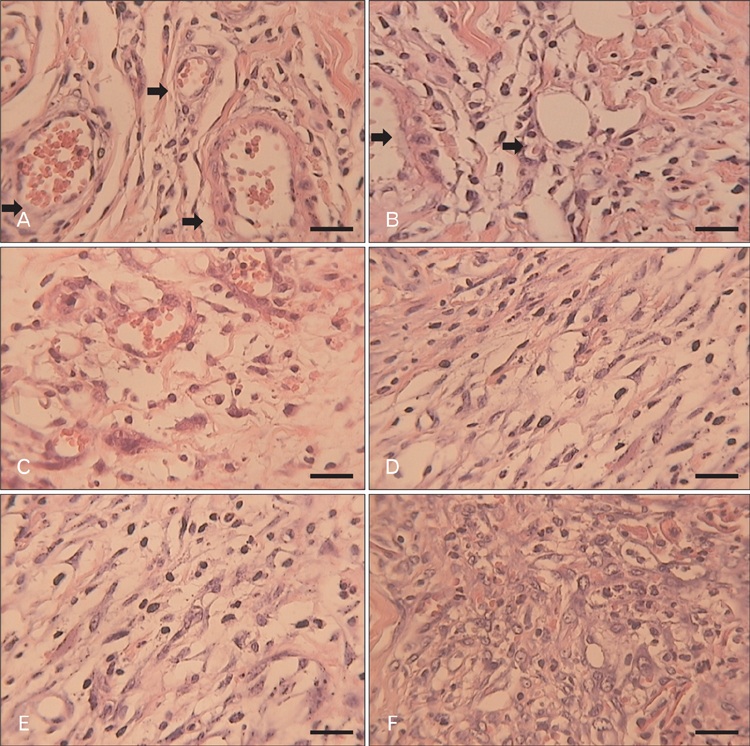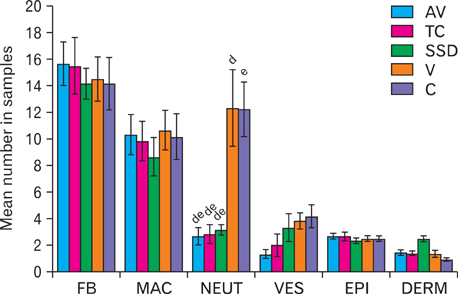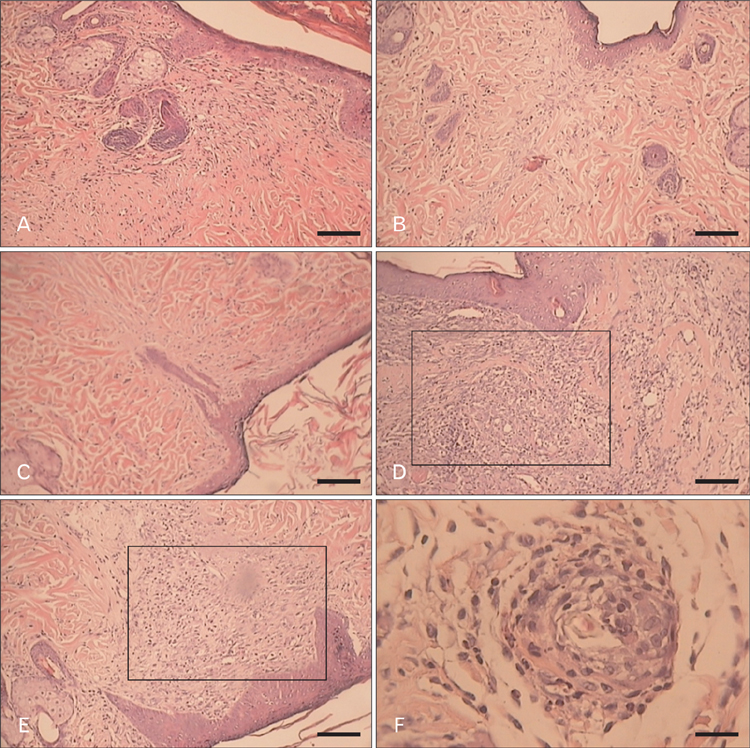Anat Cell Biol.
2012 Sep;45(3):170-177. 10.5115/acb.2012.45.3.170.
Aloe vera gel and thyroid hormone cream may improve wound healing in Wistar rats
- Affiliations
-
- 1Department of Anatomy and Cell Biology, Shahid Beheshti University of Medical Sciences, Tehran, Iran. m.taramoshlou@sbmu.ac.ir
- 2English Language Department, Shahid Beheshti University of Medical Sciences, Tehran, Iran.
- 3Department of Pathology, AJA University of Medical Sciences, Tehran, Iran.
- 4Department of Pathology, Shahid Beheshti University of Medical Sciences, Tehran, Iran.
- 5Department of Anatomy and Cell Biology, Gilan University of Medical Sciences, Rasht, Iran.
- KMID: 2046744
- DOI: http://doi.org/10.5115/acb.2012.45.3.170
Abstract
- Therapeutic effects of various treatment options in wound healing have been one of the most controversial issues in surgical science. The present study was carried out to examine and compare the effects of Aloe vera gel, thyroid hormone cream and silver sulfadiazine cream onsutured incisions in Wistar rats. In a randomized controlled trial, thirty-six Wistar male rats, 250 to 300 g, received surgical incisions followed by topical application of Aloe vera gel, thyroid hormone cream and silver sulfadiazine 1%. To assess the efficacy of each treatment technique, a histological approach was used to evaluate the mean number of fibroblasts, macrophages, neutrophils, blood vessel sections and thickness of the regenerating epithelium and dermis on days 4, 7 and 14. Re-epithelialization and angiogenesis were significantly improved in Aloe vera gel group compared with the other treatments while thyroid hormone cream had positive effects on day 4 (P< or =0.05). Topical administration of Aloe vera gel is recommended as the treatment of choice for surgical incisions.
Keyword
MeSH Terms
Figure
Reference
-
1. Singer AJ, Clark RA. Cutaneous wound healing. N Engl J Med. 1999. 341:738–746.2. Peacock EE, Cohen IK. McCarthy JG, May JW, Littler JW, editors. Wound healing. Plastic Surgery. 1990. Vol. 1. Philadelphia: W.B. Saunders Company;161–185.3. Newman JT, Morgan SJ, Resende GV, Williams AE, Hammerberg EM, Dayton MR. Modality of wound closure after total knee replacement: are staples as safe as sutures? A retrospective study of 181 patients. Patient Saf Surg. 2011. 5:26.4. Hans G, Joukes E, Verhulst J, Vercauteren M. Management of neuropathic pain after surgical and non-surgical trauma with lidocaine 5% patches: study of 40 consecutive cases. Curr Med Res Opin. 2009. 25:2737–2743.5. Mooney EK, Lippitt C, Friedman J. Plastic Surgery Educational Foundation DATA Committee. Silver dressings. Plast Reconstr Surg. 2006. 117:666–669.6. Cohen SM, Rousseau ME, Robinson EH. Therapeutic use of selected herbs. Holist Nurs Pract. 2000. 14:59–68.7. Feily A, Namazi MR. Aloe vera in dermatology: a brief review. G Ital Dermatol Venereol. 2009. 144:85–91.8. Chithra P, Sajithlal GB, Chandrakasan G. Influence of aloe vera on the healing of dermal wounds in diabetic rats. J Ethnopharmacol. 1998. 59:195–201.9. Holt PJ. In vitro responses of the epidermis to triiodothyronine. J Invest Dermatol. 1978. 71:202–204.10. Ahsan MK, Urano Y, Kato S, Oura H, Arase S. Immunohistochemical localization of thyroid hormone nuclear receptors in human hair follicles and in vitro effect of L-triiodothyronine on cultured cells of hair follicles and skin. J Med Invest. 1998. 44:179–184.11. Safer JD, Fraser LM, Ray S, Holick MF. Topical triiodothyronine stimulates epidermal proliferation, dermal thickening, and hair growth in mice and rats. Thyroid. 2001. 11:717–724.12. Safer JD, Crawford TM, Fraser LM, Hoa M, Ray S, Chen TC, Persons K, Holick MF. Thyroid hormone action on skin: diverging effects of topical versus intraperitoneal administration. Thyroid. 2003. 13:159–165.13. Erdoğan M, Ilhan YS, Akkuş MA, Caboğlu SA, Ozercan I, Ilhan N, Yaman M. Effects of L-thyroxine and zinc therapy on wound healing in hypothyroid rats. Acta Chir Belg. 1999. 99:72–77.14. Safer JD, Crawford TM, Holick MF. A role for thyroid hormone in wound healing through keratin gene expression. Endocrinology. 2004. 145:2357–2361.15. Pirk FW, ElAttar TM, Roth GD. Effect of analogues of steroid and thyroxine hormones on wound healing in hamsters. J Periodontal Res. 1974. 9:290–297.16. Ladenson PW, Levin AA, Ridgway EC, Daniels GH. Complications of surgery in hypothyroid patients. Am J Med. 1984. 77:261–266.17. Ward RS, Saffle JR. Topical agents in burn and wound care. Phys Ther. 1995. 75:526–538.18. Lansdown AB, Sampson B, Laupattarakasem P, Vuttivirojana A. Silver aids healing in the sterile skin wound: experimental studies in the laboratory rat. Br J Dermatol. 1997. 137:728–735.19. Cooper ML, Laxer JA, Hansbrough JF. The cytotoxic effects of commonly used topical antimicrobial agents on human fibroblasts and keratinocytes. J Trauma. 1991. 31:775–782.20. Leitch IO, Kucukcelebi A, Robson MC. Inhibition of wound contraction by topical antimicrobials. Aust N Z J Surg. 1993. 63:289–293.21. Muller MJ, Hollyoak MA, Moaveni Z, Brown TL, Herndon DN, Heggers JP. Retardation of wound healing by silver sulfadiazine is reversed by Aloe vera and nystatin. Burns. 2003. 29:834–836.22. Atiyeh BS, Costagliola M, Hayek SN, Dibo SA. Effect of silver on burn wound infection control and healing: review of the literature. Burns. 2007. 33:139–148.23. Tarameshloo M, Norouzian M, Zarein-Dolab S, Dadpay M, Gazor R. A comparative study of the effects of topical application of Aloe vera, thyroid hormone and silver sulfadiazine on skin wounds in Wistar rats. Lab Anim Res. 2012. 28:17–21.24. Safer JD, Crawford TM, Holick MF. Topical thyroid hormone accelerates wound healing in mice. Endocrinology. 2005. 146:4425–4430.25. Redondo P, Guzmán M, Marquina M, Pretel M, Aguado L, Lloret P, Gorrochategui A. Repigmentation of gray hair after thyroid hormone treatment. Actas Dermosifiliogr. 2007. 98:603–610.26. Davis RH, Kabbani JM, Maro NP. Aloe vera and wound healing. J Am Podiatr Med Assoc. 1987. 77:165–169.27. Lee MJ, Lee OH, Yoon SH, Lee SK, Chung MH, Park YI, Sung CK, Choi JS, Kim KW. In vitro angiogenic activity of Aloe vera gel on calf pulmonary artery endothelial (CPAE) cells. Arch Pharm Res. 1998. 21:260–265.28. Moon EJ, Lee YM, Lee OH, Lee MJ, Lee SK, Chung MH, Park YI, Sung CK, Choi JS, Kim KW. A novel angiogenic factor derived from Aloe vera gel: beta-sitosterol, a plant sterol. Angiogenesis. 1999. 3:117–123.29. Hosseinimehr SJ, Khorasani G, Azadbakht M, Zamani P, Ghasemi M, Ahmadi A. Effect of aloe cream versus silver sulfadiazine for healing burn wounds in rats. Acta Dermatovenerol Croat. 2010. 18:2–7.30. Smoot EC 3rd, Kucan JO, Roth A, Mody N, Debs N. In vitro toxicity testing for antibacterials against human keratinocytes. Plast Reconstr Surg. 1991. 87:917–924.31. Poon VK, Burd A. In vitro cytotoxity of silver: implication for clinical wound care. Burns. 2004. 30:140–147.
- Full Text Links
- Actions
-
Cited
- CITED
-
- Close
- Share
- Similar articles
-
- A comparative study of the effects of topical application of Aloe vera, thyroid hormone and silver sulfadiazine on skin wounds in Wistar rats
- Anti-irritant Effect of Aloe Vera Gel Against a Lactic Acid Sting Test Reaction
- A Study on Anti-irritant Effect of Aloe Vera Gel Against the Irritation of Sodium Lauryl Sulfate
- Ethanol extract of aloe vera ameliorates Artemether-Lumefantrine-induced reproductive toxicity in adult male Albino rats (Wistar Strain)
- Anti-inflammatory and Anti-bacterial Effects of Aloe vera MAP against Multidrug-resistant Bacteria

